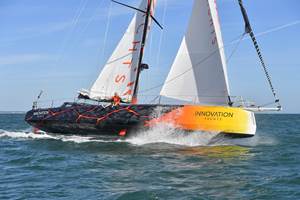San Diego Composites canisters complete two successful launches
San Diego Composites' Lightweight Low-Cost Canister is part of a US Army-sponsored SBIR program.
San Diego Composites Inc. (SDC, San Diego, CA, US) participated in two successful launches of Lockheed Martin’s Miniature Hit to Kill (MHTK) missile in February and March 2015 to test SDC’s Lightweight Low-Cost (LLC) Canister.
SDC’s LLC Canister is in development as part of a US Army-sponsored SBIR program for the Indirect Fire Protection Capability Increment 2 – Intercept (IFPC Inc 2-I) and Extended Area Protection and Survivability (EAPS) programs. The first launch test was conducted by AMRDEC at Redstone Arsenal in Alabama, US; the second launch test was conducted by the Army at White Sands Missile Range (WSMR) in New Mexico, US.
In both tests, Lockheed Martin’s missile launched from SDC’s LLC Canister and demonstrated successful functionality. The test at WSMR was attended by numerous representatives from the Army, Aviation and Missile Research, Development and Engineering Center (AMRDEC), and Lockheed Martin and concluded a week-long series of testing for the Army’s Multi-Mission Launcher (MML) IFPC Inc 2-I program.
“This test proved the MHTK interceptor can be successfully launched from a MML in a tactical design LLC Canister," says Roger Reed, Missiles and Fire Control’s Launcher Integrated Product Team (IPT) and Mechanical Design lead. "The missile is designed to be flexible and small enough to allow multiple MHTK interceptors to be packaged in a single MML tube, which increases the Counter – Rocket, Artillery and Mortar (C-RAM) magazine depth. All SDC LLC Canister test objectives were successful demonstrated.”
SDC developed the LLC Canister with Army-sponsored Small Business Innovative Research (SBIR) funding over the last two years. Lockheed Martin and the Army provided SDC with requirements, approved design and analysis packages, and led flight testing and integration. To reduce risk prior to the launch tests, SDC conducted several tests at its San Diego facility to verify canister performance, including drop shock, mechanism functionality, cover burst and a full system-level speed egress test, which simulated the kinematic event of the missile launching from the canister.
“Completing the LLC Canister program with two successful launch tests is a huge accomplishment," says Megan Caprio, SDC EAPS Canister program manager. "It is always our goal to integrate the technologies we develop in SBIR programs into functional platforms. The LLC Canister program marks one of SDC’s most successful SBIR programs to date and we could not have done it without the Army’s or Lockheed Martin’s support. We look forward to continuing development and providing the Army with an LLC Canister that enables IFPC Inc 2-I Mission success.”
SDC’s LLC Canister enables launching of multiple missiles from a single launcher while safely isolating adjacent missiles from plume, shock, electrical, structural, and mechanical environments.
The benefits of SDC’s LLC Canister are:
- Lightweight – The LLC Canister weighs less than 20 lb/9.1 kg, which makes the All-Up-Round weight very manageable for the warfighter. SDC used a combination of composite, metallic, and plastic parts to meet all structural, electrical, and environmental requirements.
- Low cost – In production, the LLC Canister cost is less than the budgeted amount based on SDC using several manufacturing methods to develop an affordable solution, such as filament winding for the composite outer tube, pultrusion for the composite body guides, and injection molding for the desiccant assembly housing. Also, off-the-shelf components were selected over custom parts to reduce cost.
- Low risk – SDC was able to leverage its experience with canister development and production to provide a low-risk canister solution. Military-standard parts and high Technology Readiness Level (TRL) materials and technologies were used to build mission assurance into the canister.
- High quality – SDC is AS9100 Certified and is an approved supplier for numerous aerospace industry prime contractors. SDC uses its high-standard quality system for all development and production programs, which accelerates product qualification.
Related Content
European boatbuilders lead quest to build recyclable composite boats
Marine industry constituents are looking to take composite use one step further with the production of tough and recyclable recreational boats. Some are using new infusible thermoplastic resins.
Read MoreJEC World 2024 highlights: Glass fiber recycling, biocomposites and more
CW technical editor Hannah Mason discusses trends seen at this year’s JEC World trade show, including sustainability-focused technologies and commitments, the Paris Olympics amongst other topics.
Read MoreCorebon induction heating
This sidebar to CW’s August 2024 feature article reviews this technology for more efficient composites manufacturing and why it aligns with Koridion active core molding.
Read MoreBladder-assisted compression molding derivative produces complex, autoclave-quality automotive parts
HP Composites’ AirPower technology enables high-rate CFRP roof production with 50% energy savings for the Maserati MC20.
Read MoreRead Next
Ultrasonic welding for in-space manufacturing of CFRTP
Agile Ultrasonics and NASA trial robotic-compatible carbon fiber-reinforced thermoplastic ultrasonic welding technology for space structures.
Read MoreScaling up, optimizing the flax fiber composite camper
Greenlander’s Sherpa RV cab, which is largely constructed from flax fiber/bio-epoxy sandwich panels, nears commercial production readiness and next-generation scale-up.
Read MoreCeramic matrix composites: Faster, cheaper, higher temperature
New players proliferate, increasing CMC materials and manufacturing capacity, novel processes and automation to meet demand for higher part volumes and performance.
Read More












